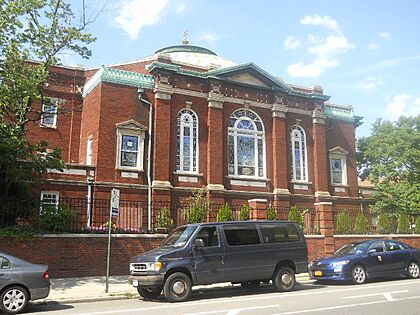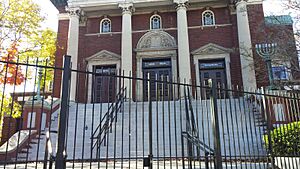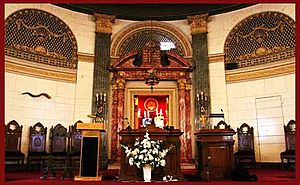Free Synagogue of Flushing facts for kids
Quick facts for kids Free Synagogue of Flushing |
|
|---|---|

The synagogue as seen from Kissena Boulevard and Sanford Avenue
|
|
| Religion | |
| Affiliation | Reform Judaism |
| Ecclesiastical or organisational status | Synagogue |
| Status | Active |
| Location | |
| Location | 41-60 Kissena Boulevard, Flushing, Queens, New York City, New York 11355 |
| Country | United States |
| Architecture | |
| Architect(s) | Maurice Courland |
| Architectural type | Synagogue |
| Architectural style | Neoclassical |
| Date established | 1917 (as a congregation) |
| Completed | 1921 |
| Specifications | |
| Dome(s) | One |
| Materials | Masonry, copper, timber, asphalt |
The Free Synagogue of Flushing is a historic synagogue located in the Flushing neighborhood of Queens in New York City. It follows the Reform Jewish tradition. This synagogue was founded on the idea of a "free synagogue" movement. The building was added to the National Register of Historic Places in 2009, recognizing its importance.
Contents
History of the Synagogue
The Free Synagogue of Flushing started in 1917. It was founded by the Hebrew Women's Aid Society. This group followed the ideas of the first Free Synagogue in Manhattan, started by Stephen Samuel Wise.
What "Free Synagogue" Means
Rabbi Wise explained the meaning of a "free synagogue" in 1906. He said it meant the pulpit (where the rabbi speaks) would be free and honest. It would share important moral and spiritual teachings without fear. This idea helped synagogues connect with people.
The main ideas of a "free synagogue" include:
- Freedom for the rabbi to speak openly.
- Freedom in religious beliefs.
- Freedom in seating, meaning no assigned seats.
- Men and women having equal roles in the synagogue.
For most of its history, this synagogue has been known for its open-mindedness. It has also been active in social causes. It is the oldest Reform Jewish congregation in the Queens area.
Building the First Synagogue
When the synagogue began, it bought a white house at Kissena Boulevard and Sanford Avenue. This first building was a grand mansion with pillars. It was designed by a famous architectural firm.
As more people joined, the synagogue needed a bigger space. During World War I, the Hebrew Women's Aid Society hired architect Maurice Courland. He was asked to build a new synagogue on Kissena Boulevard.
Early Rabbis and Leaders
In its early years, the synagogue had a few rabbis for short times. One was Rabbi Bernard Cantor. He went on a mission to help Jewish people in Eastern Europe. Sadly, he was killed by bandits in Russia. The synagogue still remembers the anniversary of his death.
Rabbi Cantor was followed by Rabbi Abraham J. Feldman. Then came Rabbi Maxwell Silver, whose brother was a famous leader named Abba Hillel Silver. In 1922, Rabbi Max Meyer came to serve. He was supposed to be "temporary" but stayed for 40 years! Rabbi Meyer was key to the synagogue's growth.
Rabbi Charles Agin joined in 1958 to help Rabbi Meyer. He quickly became very popular. After Rabbi Meyer retired, Rabbi Agin took over. He served for 50 years! During his time, the synagogue expanded. They added a new administration building and the Rabbi Max Meyer Religious School. This school helps children aged 6 to 16 learn about Hebrew.
Recent Events and Community Role
In September 2008, Michael Weisser became the rabbi. He had been a cantor (a singer who leads prayers) before becoming a rabbi. Rabbi Weisser helped organize the Queens Unity Walk. This event brings people of different faiths together to learn from each other. He also helped create an interfaith council in Queens.
A Story of Change
Rabbi Weisser has a remarkable story. When he was a cantor in Nebraska, a leader of a hate group, Larry Trapp, threatened him. Instead of being afraid, Rabbi Weisser reached out to Mr. Trapp. He became friends with him and helped Mr. Trapp change his views. Mr. Trapp, who had been a racist his whole life, began speaking out against hatred. Before he passed away in 1992, Mr. Trapp even converted to Judaism with Rabbi Weisser's help. This happened in the very synagogue he once planned to harm. A book and an opera called Slaying the Dragon were made about this amazing story. Rabbi Weisser retired in June 2016.
Music and Leadership Today
Steven Pearlston was the synagogue's cantor and music director for 35 years. He was known for his wide knowledge of Jewish music. The Free Synagogue of Flushing was the only synagogue in Queens with a professional choir at all services. The choir performed behind a beautiful grate above the Ark. In 1923, the synagogue got an organ. It is considered one of the finest organs in Europe.
As of August 2022, Rabbi Nathan Alfred leads the Free Synagogue of Flushing. He has served congregations in places like Luxembourg, Singapore, and Israel. Cantor Alan Brava is also part of the leadership team.
The synagogue has active programs for young people and adults. It also provides space for different community groups. Throughout its history, the synagogue has been involved in social action. Every year, it celebrates Martin Luther King Jr.'s birthday. It also hosts events where different faiths can meet and talk. Since 2020, the synagogue has run a food drive for its neighbors. It also served as a vaccination site during the COVID-19 pandemic.
The Synagogue Building
The original white Victorian-style building was moved in 1926. This made space for the current, larger synagogue. The new building was designed by Maurice Courland. He was an expert in synagogue design. It has a grand entrance with four large Ionic pillars.
Inside, the sanctuary is magnificent. Dark green pillars support the walls, and a huge dome covers the ceiling. The building is decorated with Jewish symbols, like a seven-branched menorah outside the doors. Tiffany style stained glass windows from Czechoslovakia fill the sanctuary with bright colors. Above the entrance, a verse from the Bible is written: "FOR MINE HOUSE SHALL BE CALLED A HOUSE OF PRAYER FOR ALL PEOPLE" (Isaiah 56:7).
The stained-glass windows show scenes like Noah's Ark and the Lion of Judah. They also feature leaves, vines, and flowers used in the Sukkot prayer. The windows also show the two hands of the Priestly Blessing. In the center of the domed ceiling, there is a smaller stained-glass dome. It has a Star of David design. The wood inside is dark green and decorated with intricate, hand-carved gold designs. The synagogue is designed "in-the-round," which makes services feel more personal. In 1964, a three-story school building was added for religious classes.
The Free Synagogue of Flushing is listed on both the New York State and National Register of Historic Places.
From 2009 to 2011, the synagogue building went through a big renovation. The New York Landmarks Conservancy gave an award for restoring its beautiful stained glass windows. In December 2011, the synagogue celebrated its new stained glass windows with prayers.
See also
- Stephen Wise Free Synagogue





